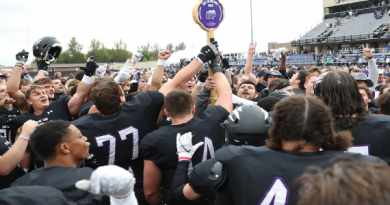Football: Not The Only Dangerous Sport
In 2012, over 3.5 million concussions were reported in athletes nation wide, double what was reported in 2002. Common symptoms of a concussion range from fatigue to a mild headache, but long term sustaining too many concussions can result in permanent brain damage.
At the University of Sioux Falls trainers take extra precaution to secure the safety of their players. Although widely publicized in Football, concussions happen in every sport. AUSF soccer player, Alexa D’Acunto says football is not the only sport an athlete can receive a concussion in.
“Dangers of playing soccer I would say [are] probably pretty closely related to football injuries because we are a heavily contacted sport and it is easy for us to get concussions, that is probably the biggest injury that we can get.,” says D’Cunto.
Football is considered to be a dangerous sport because of the many injuries that can happen.
“Football is the one that is going to get the most attention because it is the most violent sport there is,” Mathers says.
This year, USF has had only two football concussions, two concussions within the swimming program, and two concussions with the softball program. So,
“Really with the numbers this year it does not matter, there is always that chance that they can happen, regardless of sport,” Mathers says.
Former USF softball player Miranda Cain once suffered a head injury during practice.
“We were just running drills and one of my teammates while I was fielding, she was the base runner who hit,” Cain says. “She ran into me and I kind of got blindsided and immediately did not know where I was and I was not okay, but I practiced because that is what you did, I was a underclassmen and I wanted to play so desperately.”
After the conclusion of practice, Cain went back to her dorm, took a shower, and slept for several days which she has no recollection of. Along with confusion, other symptoms of a concussion include nausea, headaches, and blurry vision.
Coaches and training staff try to prevent injuries by practicing smart and making sure players are using the proper protective gear.
“First and foremost, with just practicing smart we try to limit the number of full speed blows that can happen,” Mathers says.” It is not always the physical contact with the head, it can be the whipping of the head and the whiplash effect and a lot of different things that can cause a concussion.”
At USF, each concussion case is handled on a case-by-case study by the training staff.
“The coaching staff really we try to keep them out of any decision making process when it comes to returning to play from a concussion. Emotion gets too involved, we really try to stick to evaluations, we use our physicians on hand [with] every single concussion case,” Mathers says.
After sustaining a concussion, an athlete must pass a baseline impact examination before returning to practice.
“The training staff and the coaching staff at least in my particular sport, with softball, did a good job of being aware that concussions are serious. That’s your brain and if you’re brain can’t function the way it’s supposed to, that’s not going to affect your play as an athlete, it’s going to affect who you are,” Cain says.
Although studies have been completed on the short term effects of head injuries, research continues on the long term side effects. With that in mind, coaches and trainers to their best to keep USF athletes safe.
Story by Whitney Fryer, Ellie Herman, Jill Langland, & Casey Kelderman



